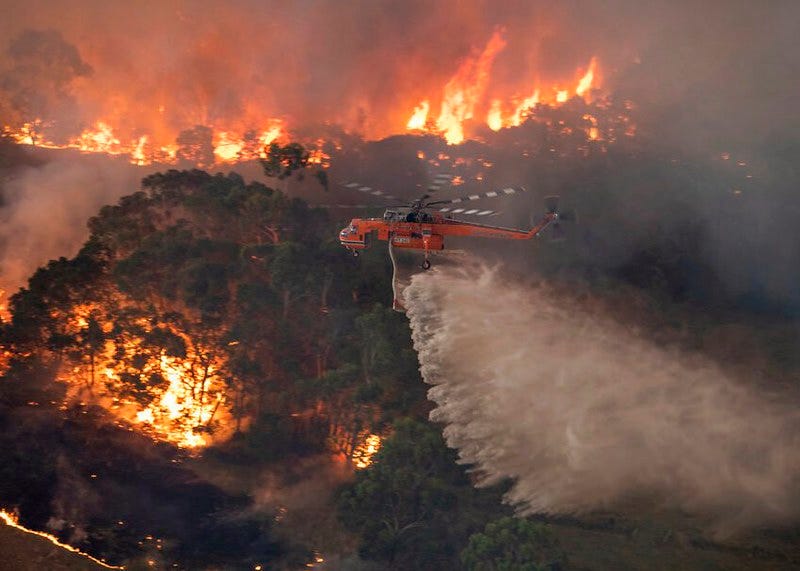Australia’s Bushfires: Learning from the burns
By Christina McConney Biology, 2021

Australia has been on fire as of late — literally. In case you haven’t been following the news, Australians have been battling ferocious bushfires, which have ravished around 1.65 million hectares in the state of New South Wales since January 6th, 2020. Firefighters, both Australian and international, have been risking their lives to attempt to quell the raging fires from destroying much of the continent. Though faced with a frightening situation, these brave individuals at least have a fighting chance to defend themselves from the fires by having a diversity of tools and methods at their disposal (equipping firefighters with mobile water crews, helitacks to aid from the sky, and the knowledge of fire specialists to develop fire safety plans). But there are some individuals who were not privy to such means of protection and instead perished in the blazes: the nearly half a billion mammals, reptiles, and birds in much of the affected areas who lost their lives in their battle against nature. In order to understand how the fires were able to displace so many individuals and animals alike, two questions have to be answered: what pre-existing environmental conditions persisted allowing for such catastrophic burning to take place? And what does this mean for the future of Australia’s ecosystems?
Australians have been battling ferocious bushfires, which have ravished around 1.65 million hectares in the state of New South Wales, since January 6th, 2020
Australia’s wildfire season spans from November to February (late spring to early summer), with the actual spread of wildfires mandated by four main conditions. First, the fires need fuel covering an expansive range — this allows wildfires not only to burn, but also to travel. Second, the fuel in question needs to be dry enough that the material can actually burn. The third and fourth requirements are an ignition source (whether that be lighting storms or man-made fires) and optimal weather conditions which would allow for the fire to spread. One component of the 2020 wildfires that made this event so devastating, and has caused concern for many within the scientific community, was the fact that the fires in question went outside the expected range of impact. The fires typically need very dry material to burn, such as dry plant biomass; however, areas that were considered to be moist enough to avoid being affected were burnt through. In many cases, these typically “immune” wet areas were rich with flammable organic material, allowing the fires to consume the surrounding plant life.
Australia’s wildfires took the news by storm, but once the fires stopped, the real battle began.
So, what do these fires mean for Australia’s ecosystem? The first thing to consider is the fact that bushfires are an intrinsic part of the continent’s natural environment. Much of the plant life found within is prone to burn — residing in areas commonly plagued with drought and dry plant material) — and many others rely upon seasonal bushfires in order to regenerate. These fires are also an important part of the culture, as they’re used by indigenous Australians to clear land for agricultural purposes. However, the severity of this season’s fires has presented a new cause for concern.
Tall and moist eucalyptus forests, ubiquitously found around the continent, are usually spared from the impact of the fires, but are now starting to be affected more frequently than ever before. In these ecosystems, local wildlife are not only not used to recovering from the effects of wildfire damage, but are now being forced to do so at a much higher rate. Without the chance to properly recover from one burn, the species found within these forests are losing long-term habitats.
Without the chance to properly recover from one burn, the wildlife species found within these forests are losing long-term habitats.
Koalas are one of the more popular inhabitants of eucalyptus forests. If they were able to survive the raging fires that devastated their natural habitat, they now face new dangers: predators. The protection that they previously enjoyed from their arboreal homes is now gone, allowing predators easy access to these lovable marsupials. This is a problem faced by many species that are fortunate enough to survive the initial threat of wildfires. The problems don’t stop once the fires have ceased, with the aftermath just as harrowing as the ignition.
Australia’s wildfires took the news by storm, but once the fires were controlled, the real battle began. Fears that much of the ecosystem is unrecoverable is a problem scientists are now facing — loss of indigenous plant life as well as wildlife could wreak havoc on the now fragile ecosystem left behind.
DOI: 10.1111/gcb.14987
